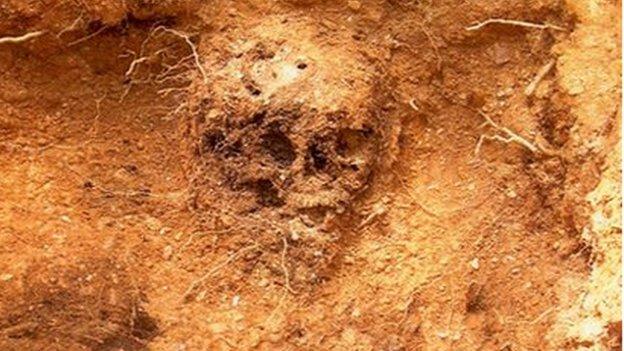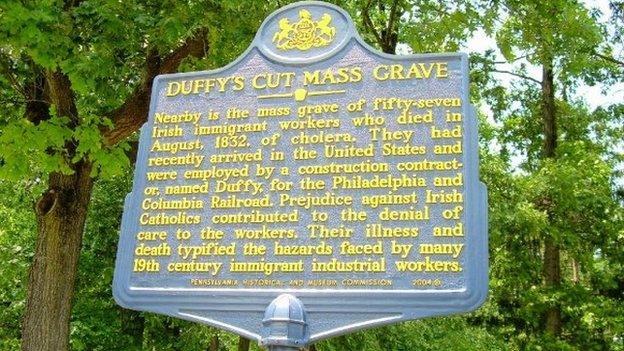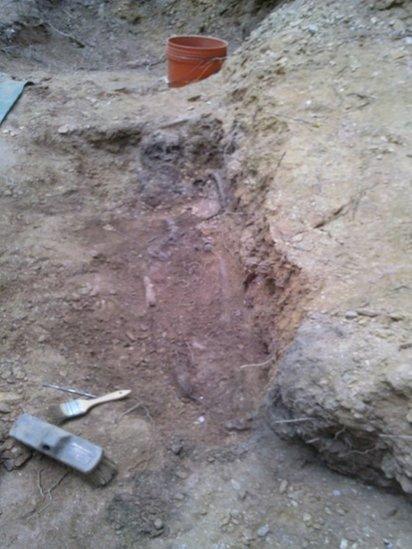Duffy's Cut: Woman murdered in Philadelphia in 1832 reburied in NI
- Published

Catherine Burns' skull as it was excavated in August 2010
A wake is being held in County Tyrone for a 29-year-old woman who was buried in an unmarked grave in America 183 years ago.
Catherine Burns, a widow from the village of Clonoe near Coalisland, was murdered in 1832 after arriving in Philadelphia to start a new life.
Her remains have been returned to Northern Ireland and she will be buried in her native County Tyrone on Sunday.
The wake in the Washingbay Centre in Clonoe, welcomes Catherine back with music, dance and song.
"The people of the village have really connected with Catherine and there has been huge interest from parishioners in her story and the story of Irish emigrants," said parish priest, Fr Benny Fee.
He added that during the wake, historian Damian Woods would speak about that period in Irish history and the background to Catherine and other emigrants' stories.
"There will be Irish dancing and local singer Oliver Robinson will perform the Christy Moore song Duffy's Cut which was written about the railroad workers.
"There will be a Requiem Mass for Catherine on 19 July at 12:30 BST at St Patrick's Church in Clonoe and everyone is welcome to attend," added Fr Fee.

A memorial stone to those who died at Duffy's Cut
Along with 56 other immigrants from counties Donegal, Tyrone, and Londonderry, Catherine had been hired by fellow Irishman Philip Duffy to build a stretch of railway between Philadelphia and Columbia.
The stretch, which was part of America's pioneering Pennsylvania railroad, is now known as Duffy's Cut.
Within six weeks of arriving in Philadelphia, all 57 workers were dead.
Most were buried anonymously in a mass grave near the shanty town where they lived and worked, but Catherine was among several workers buried separately.
Officials with the Philadelphia and Columbia railroad never notified the immigrants' families of their deaths.
It is thought some died from cholera, while others were murdered by local people who believed the immigrants were spreading the disease.
The story of Catherine Burns highlights the plight of many Irish emigrants who sailed to America. Some were able to make a new life for themselves and their families, but not everyone found that the streets were paved with gold.
After the death of her husband, Catherine, her father-in-law John Burns, and 68 other people from County Tyrone left Ireland on board the ship John Stamp, all hoping for a better life in the new world.
"Catherine's story of hopes dashed and dreams shattered is not unique," said Fr Fee.
"In honouring her homecoming, we are honouring countless other exiles who sailed out of Ireland in the hope of a new life, but who did not find the streets paved with gold."

The skeletal remains of Irish emigrant Catherine Burns
This is the second repatriation of remains found at Duffy's Cut, now a wooded area behind suburban homes in the borough of Malvern, about 20 miles west of Philadelphia.
In 2013, 18-year-old John Ruddy was reburied at Ardara, County Donegal.
Researchers identified Ruddy from railroad archives, his small bone size and a congenital missing molar that relatives said runs in the family.
The remaining bones that were exhumed, including Burns' (whose remains were discovered five years ago, but could not be fully identified), were interred at West Laurel Hill cemetery in Bala Cynwyd, Pennsylvania, in 2012.
However, the discovery of further bones, and the fact that Catherine was one of the few female passengers on the John Stamp, led to a positive identification and subsequent repatriation.
Investigation into what happened to the 57 Irish workers began in 2002, when Malvern's Immaculata University professor Bill Watson, his twin brother Frank, a Lutheran minister, and fellow Immaculata professor Earl Schandelmeier, began the Duffy's Cut archival and research project.
Bill, Frank and Earl accompanied Catherine on her journey home to County Tyrone and will attend the wake and the funeral in Clonoe.
It is their mission, he said, "to make the recovery of the rest of the Irish labourers buried there possible, and to tell the full story of those who lost their lives helping to build America".

The memorial cross at Duffy's Cut grave at West Laurel Hill Cemetery, Bala Cynwyd, Pennsylvania. Included are Frank and Bill Watson and their colleague Earl Schandelmeier
Writing on the Duffy's Cut website, Bill Watson said: "We believe Catherine was murdered in an attempt to contain the cholera epidemic, which locals believed was being spread by the immigrant railroad workers.
"Her skull shows massive perimortem violence by means of a sharp implement which would have caused her death."
He added: "The workers were a convenient scapegoat for the community, which did not understand the cause of the disease.
"All of the bodies we have excavated were healthy and showed no sign of defensive wounds which indicates that they may have been bound.
"One man died from being shot in the head after being struck by with an axe."
He also said the coffins were sealed with a large number of nails - averaging more than 100 - to prevent them from being opened.
In the Clonoe parish bulletin, Fr Fee wrote: "Les Miserables is a great musical and my favourite song in it is, Bring Him Home.
"These days I find myself humming that tune because the parish is not bringing him home, they are bringing her, Catherine, home."
- Published18 May 2015
